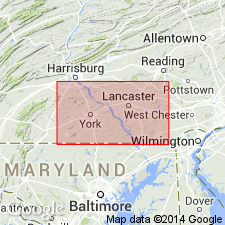
- Usage in publication:
-
- Kreutz Creek Member
- Modifications:
-
- Overview
- AAPG geologic province:
-
- Piedmont-Blue Ridge province
Summary:
Conestoga Limestone in report area is divided into three members. Most spectacular lithofacies of the Conestoga is the polymictic megaconglomerate or megabreccia at the base. These debris flow deposits include clasts ranging upward to 30 ft or more and are referred to as the West York Member. This member is replaced to the southeast by the Kreutz Creek Member which consists of dark lime mudstones and phyllite. The Wrightsville Member overlies both the West York and the Kreutz Creek and shows a general increase in the percentage of argillaceous lithologies and a decrease in peloidal and lithoclastic limestones toward the southeast and a change from slope or proximal submarine fan deposition in the northwest to mid-fan environments to the southeast. [Because members were named by G. Gohn (1976) in a Ph.D dissertation they are considered informal by the GNU.]
Source: GNU records (USGS DDS-6; Reston GNULEX).
For more information, please contact Nancy Stamm, Geologic Names Committee Secretary.
Asterisk (*) indicates published by U.S. Geological Survey authors.
"No current usage" (†) implies that a name has been abandoned or has fallen into disuse. Former usage and, if known, replacement name given in parentheses ( ).
Slash (/) indicates name conflicts with nomenclatural guidelines (CSN, 1933; ACSN, 1961, 1970; NACSN, 1983, 2005, 2021). May be explained within brackets ([ ]).

